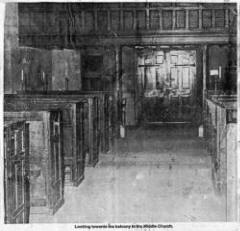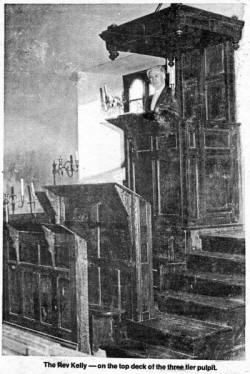
THE CANON OF PERU TUMBLES IN LA LOO
 NOW, what a strange story I have to tell you. - The honorary Church of
Ireland canon of Bolivia and Peru, went "head over heels" in the graveyard
of La Loo.
NOW, what a strange story I have to tell you. - The honorary Church of
Ireland canon of Bolivia and Peru, went "head over heels" in the graveyard
of La Loo.
That might sound like a tongue twister, or the start of a Limerick, but the Rev Wilbert Kelly was lucky not to end up with an ankle-twister when showing me through the ancient cemetery at Ballinderry Co. Antrim.
It was to Ballinderry that my nomadic ramblings led me a few days ago, and Mr Kelly who has been rector there for the past five years - and who is a gentleman of high humour, to say nothing of graciousness - told me something of the history of his church.
LA loo was the original pre-Reformation place of worship of the area, and in the graveyard, its two stone gable walls still stand -one of them with a lush covering of dark, dark green. ivy, the other "bald.
The site is actually a little hill, and, it was when we were descending to the gate, over wet, slippery grass, that Wilbert lost his footing.
Up like a. flash, he said like a flash. "I'm only a rector, but sure it could have happened to a bishop."
And that South American connection?
He was a -missionary from 1975-1982, and retained the title of honorary canon of the .Diocese of Bolivia and Peru.
When La Loo church fell into ruin -some say at the cruel hand of Cromwell - what was known as the Middle Church was built, in 1668
It still stands, in a state of fine repair, and it is used for. evening services - on the first and third Sundays of June, July and August. During the rest of the year the congregation uses the New Church, which was erected in 1824.
But it is the Middle Church - between Upper and Lower Ballinderry that fascinates most.
Much of the oak timbers in it came from La Loo, as did the woodwork of the pulpit, which is a treble decker, a relic probably of the Jacobean period.
And the church has no heating system or electric lighting - hence its use only in the summertime.
"But up there in the pulpit," said Wilbert, "as the daylight fades more quickly in August, it is surprising the light that the candles can provide."
 The
congregation sit facing one another in the church, and would turn their
eyes towards the pulpit rather than look straight ahead. For that
"preaching box" is at one side, not up at the front of the rectangular
building..,
The
congregation sit facing one another in the church, and would turn their
eyes towards the pulpit rather than look straight ahead. For that
"preaching box" is at one side, not up at the front of the rectangular
building..,
It still has its sandstone floor, laid on the instructions of the famous Bishop Jeremy Taylor, who built the Middle Church
And it has collecting plates on handles at least five foot long, so that they can be stretched up the pews, and not have to be passed from hand to hand.
In a corner is a large oak chest which cannot be opened for fear of breaking it, the date: 1706.
Also preserved on a wall is a wooden pew door, dated 1668.
There are more tombstones in the Middle Church graveyard than remain at La Loo -and in fact, the oldest among them was DUG UP, comparatively recently.
In years gone by it had fallen over, and as time relentlessly rolled on, it became completely covered.
"It was just found by chance," said Mr Kelly, "and we had it cleaned and brought into the church."
It is there, against a wall - the inscription almost as clear as the day it was chiselled.
When, you may ask, was that?
The epitaph reads: "Here lyeth the body of Henry Sefton, who departed this life the 98th year of his age, February 14, Anno Domini 1711. "
To look at this tombstone evinced an awesome sense of time, of humility, and of human frailty. Here was a man who lived to 98, died 277 years ago, and was born in 1613.
Yes, time brings all things to an end -- yesterday, today ... and tomorrow?
It makes you think!
